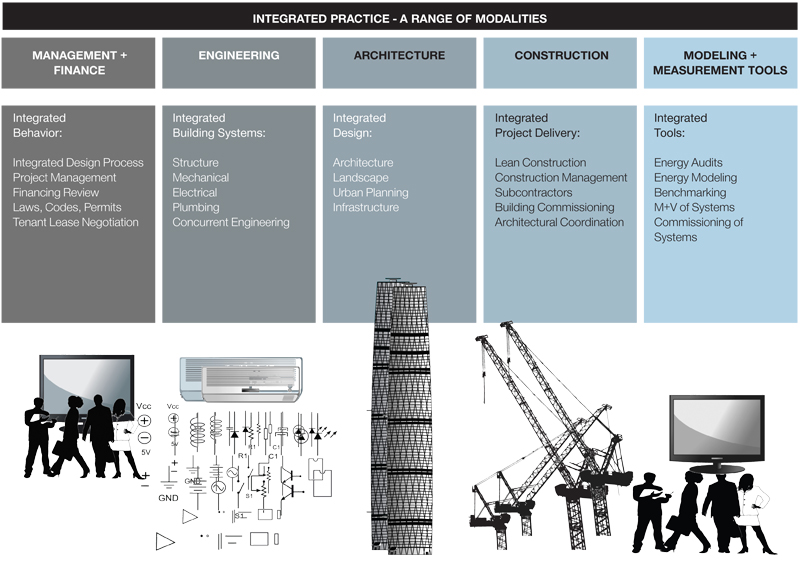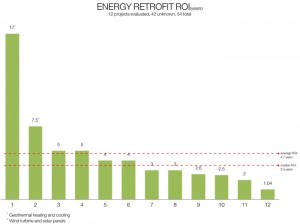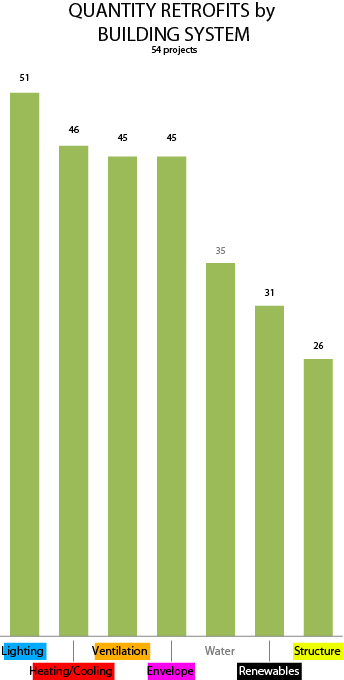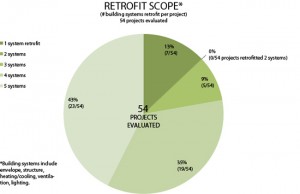The Blueprint for Advanced Energy Retrofit Success
Original research by Dr. Franca Trubiano, Assistant Professor of Architecture at University of Pennsylvania
Introduction
Retrofitting a building requires the expertise of many professions, particularly architecture, engineering, and construction (AEC). While each individual member of the building retrofit team may pursue maximum energy efficiency in his or her field of expertise – for example, an architect may design to maximize sunlight and a construction firm may install exceptionally good insulation to keep a building warmer in the winter – the deepest energy retrofits are achieved through a coordinated process, with the entire project team collaboratively naming, setting, and attaining project goals.
CBEI developed a set of “roadmaps” describing how to undertake this type of cross-disciplinary collaboration, which is an essential component of an advanced energy retrofit (AER). These guidelines, based on principles of integrated design, are called Integrated Design Roadmaps (IDRs) for AERs.
Reference Manual
Reference Manual (pdf download)
Lite Retrofit
Project Team Guide for Lite Retrofit (pdf download)
Partial Retrofit
Project Team Guide for Partial Retrofit (pdf download)
Comprehensive Retrofit
Project Team Guide for Comprehensive Retrofits (pdf download)
Substantial Retrofit
Project Team Guide for Substantial Retrofits (pdf download)
What is Integrated Design?
CBEI is committed to the adoption of Integrated Design practices in the market deployment of AERs. At present, architects employ a variety of handbooks developed by the American Institute of Architects (AIA) cover the topic of integrated design, which one source describes as “consider[ing] design variables as a unified whole and us[ing] them as problem-solving tools” [1]. In engineering, integrated design practices are referred to as “whole building design,” for which the National Institute of Building Sciences has published a design guide
[2]. Finally, the construction industry pursues a similar notion: “lean project delivery and integrated design”
[3].

The various disciplines that participate in integrated design have different expressions for integrated design. Source: CBEI
During the summer of 2012, a CBEI team led by Franca Trubiano, Assistant Professor of Architecture at the University of Pennsylvania, surveyed nine architectural practices that varied in scale and expertise to gauge CBEI’s working definition of integrated design. The CBEI team discovered that reaching agreement on a universal, one-size-fits-all definition is difficult, particularly in reference to retrofits. The lack of agreement among AEC professionals reflects the fact that each field has a unique set of concerns when it comes to energy efficient building retrofits. To remedy this, the team is looking at the larger picture in order to develop a shared definition, studying the sum of different activities performed by each profession, trying to better understand the knowledge silos that result from professional specialization, and working to eliminate the silos.
What are Integrated Design Roadmaps for Advanced Energy Retrofits?
IDRs for AERs are guidelines that help AEC professionals understand how they can work collaboratively on retrofit projects. CBEI developed four IDRs, each one describing an ideal process for a project of a particular scale, with the IDR for a Comprehensive retrofit having more steps than one for a Lite retrofit.
Each IDR will be comprised of Integrated Design protocols, which are action-based decision-making guidelines and tool sets used to facilitate the collaboration of all members on a retrofit team, including building owners, users, funders, project managers, architects, engineers, builders, modelers, auditors, and technology suppliers. Examples include guidelines describing how to develop a mission statement, oversee an integrated design request for proposal, or participate in an integrated project delivery contract.
Survey and Analysis of Commercial Retrofits
In order to better understand existing integrated design practices, as well as their future potential, the CBEI team, led by Trubiano, conducted a survey of commercial building retrofits. The team first identified buildings in CBEI’s surrounding ten-county region that had been nationally recognized as having undergone an extensive energy retrofit (in other words, they looked for buildings that had been retrofitted to achieve Energy Star, LEED, or another certification of sustainability or energy efficiency). The team closely examined those projects that used integrated design protocols, extensively surveying five local projects. Then, the Team expanded the survey to the entire country, identifying over eighty nationally recognized commercial building retrofits, fifty-four of which offered significant data for analysis.
The CBEI team’s analysis demonstrated that retrofit costs are generally recoverable within a reasonable timeframe; the median return on investment (ROI) for those buildings evaluated equaled just 3.5 years, as shown in Figure 2. Figure 3 illustrates another significant finding: projects that meet nationally recognized standards for sustainability or energy efficiency usually involve the retrofit of multiple building systems, which are broken down in Figure 4.

Figure 2: For the twelve energy retrofit projects evaluated, the median ROI was 3.5 years and the average ROI was 4.7 years. Source: CBEI

Figure 4: The types of system retrofits that were implemented shows a trend favoring systems that are traditionally regarded as easier to execute, especially with regards to lighting retrofit. Source: CBEI

Figure 3: Of the 54 projects evaluated, a majority undertook a retrofit of multiple systems simultaneously. Source: CBEI
The CBEI team identified other factors that lead to project success as well. They found that diverse, integrated design teams who set goals early via a charette are critical and that retrofits are particularly successful when the contractor is motivated by principles of sustainability (since the contractor’s team is actually executing the building process, making sure that materials are recovered and recycled, using sustainable products, and complying with requirements). Additionally, the CBEI team recognized that the complexity of planning and coordination necessary to execute an advanced energy retrofit sometimes leads to an extended design phase.
The Path to Integrated Design Roadmaps
The CBEI team is now in the process of developing IDRs. A literature review revealed other guidelines for undertaking integrated design, including the Low Carbon Retrofit Toolkit from the London-based Better Buildings Partnership, the Energy Efficient Building Retrofit Toolkit jointly prepared by the Clinton Climate Initiative and the Building Owner and Managers Association, High Performance Building Guidelines from the New York City Department of Design and Construction, and the RetrofitDepot from the Rocky Mountain Institute.
Drawing on these references as well as their own research, the CBEI team defined four retrofit project scales: Comprehensive, Substantial, Partial, and Lite (Figure 5). The CBEI team determined that each of the four requires its own IDR, since retrofit processes differ significantly based on scale, due to differences in the number of project participants, the amount of energy modeling and simulation, the request for proposal process, the measurement and verification process post-retrofit, and in opportunities for overlap among professions.

Figure 5: As retrofit scales increase in magnitude, the number of professionals involved increases, which is a factor addressed in the specific IDRs. Source: CBEI
Looking Forward: Untapped Business Opportunities
Currently, the CBEI team is collecting feedback from other researchers on draft IDRs. The CBEI team has also sought input from AEC professionals; this stakeholder group was invited to comment on the draft IDRs at an October 2012 CBEI engagement event. A similar event – this one directed at Building Owners, Operators, and Occupants took place on April 10th, 2013.
Discussions at platform meetings have highlighted a number of new business opportunities that are expected to arise as AERs become more widely implemented. Because AERs rely on integrated design, demand for expertise in coordinating complex retrofit projects is expected to grow as the demand for AERs grows. This will give AEC professionals and energy industry consultants opportunities to offer more value-added services such as design charettes, energy certifications, energy modeling services, climate analysis, building energy audits, life cycle assessments, and high performance goal setting. By developing IDRs, the CBEI is providing AEC and energy industry professionals tools they can use to guide their clients’ retrofit projects using integrated design principles and practices.
References
[1] Burke, Bill and Marian Keeler. (2009). Fundamentals of Integrated Design for Sustainable Building. Hoboken, NJ: John Wiley & Sons, Inc. Retrieved from http://books.google.com/books?id=ax_MgxXtTa8C.
[2] National Institute of Sciences. (2012). World Building Design Guide. Retrieved from http://www.wbdg.org.
[3] Forbes, Lincoln H. and Syed M. Ahmed. (2011). Lean Project Delivery and Integrated Design. Boca Raton, FL: Taylor and Francis Group, LLC. Retrieved from http://books.google.com/books?id=sL2wXr7dPE0C.
Further Reading
Trubiano, Franca. (2012). Integrated Design Roadmaps for Advanced Energy Retrofits [Presentation]. Retrieved from {filedir_8}2012-10-05_AER_Retrofit_Roadmaps_Presentation.pdf.